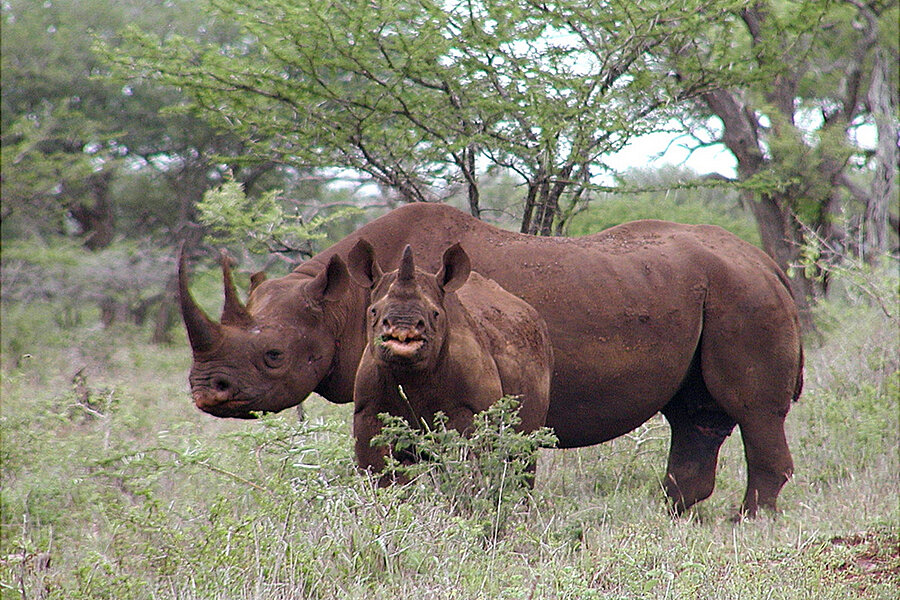Can CSI-style tactics help save Africa's rhinos?
Loading...
| Johannesburg
World leaders will gather in London this week to discuss ways to counter a flourishing illegal wildlife trade, worth $9.8 billion annually, that is pushing some of the planet's most prized species toward extinction.
The conference, which as many as 50 heads of state and government are due to attend, aims to forge agreements on how to cut international demand for illegally traded species, break up wildlife crime syndicates, and provide poachers with incentives not to kill. Much of the demand is driven by buyers in Asia.
Hosted by David Cameron, the British prime minister, the conference will feature Prince Charles and his son Prince William, who, in a pre-conference video message, cited statistics that nearly 100 elephants die each day and a rhinoceros is killed every 11 hours because of the demand for their tusks and horns.
Prince Charles said wildlife trafficking posed a grave threat "not only to the survival of some of the world’s most treasured species, but also to economic and political stability in many areas around the world.... We must treat the illegal wildlife trade as a battle because it is precisely that.”
Many tactics have been tried in the battle against poaching. These include the use of smart technology such as satellite collars for animals and drones to spot them, as well as allowing local communities to run their own game parks as an alternative to poaching.
In South Africa, there is continual debate whether to allow the expansion of so-called “rhino farms,” where horns are cut while leaving the animals alive. The horns are then sold to buyers in Asia, where rhino powder is used for medicinal purposes; horns are also carved into jewelry and ornaments.
South Africa’s environment minister is among the proponents of rhino farms on the grounds that they undercut illegal exports and drive poachers and traders out of business.
Those against the practice point to the legal sale of stockpiles of elephant ivory to Asia in 2008; that change started a boom that continues to this day. Critics say legal ivory also acts as a smokescreen for the illegal ivory it was meant to replace.
Forensic investigations
Among the speakers at a scientific symposium in the run-up to the London conference will be Rod Potter, a South African forensic wildlife investigator who conducts "crime scene investigation" (CSI) style examinations each time a rhino or elephant is killed in order to link poachers and dealers to their prey.
He argues that if police in Asia that seize wildlife products can work with scientists in Africa, many more criminal poaching rings could be dismantled.
At present, just 10 wildlife investigators cover the whole of South Africa but Dr. Potter believes more could easily be trained.
“A wildlife crime scene may be out in the bush but the techniques are the same that you would use in an urban setting,” he said.
“The critical thing is getting the right person with the right resources and training to every single scene. You can then pick up patterns, detect syndicates, and gather the evidence needed to break them," Potter says.
Dust particles
In one recent CSI-based sting operation, an alleged poaching kingpin was stopped in his car near Johannesburg after a police tip-off. Finding only an empty bag, police thought they would have to let their target go. Yet dust particles in the bag contained traces of hacked-off horns that the informant said the suspect had just sold.
This evidence linked the suspect to the deaths of two rhinos in the Kruger National Park and led to the roundup of a syndicate using South African, Chinese, and Vietnamese nationals, including a game ranger and a former policeman.
"Science provides the links, and puts the person back at the crime scene in the bush, which is crucial because when an animal is poached, there are very seldom witnesses,” Potter says.
The evidence he gathers includes skin, blood, bone, and toe nail samples from the rhino, any weapons found at the scene and any bags or clothing seized from suspected poachers nearby.
Materials are then sent to a unique rhino DNA testing laboratory at the University of Pretoria that processes forensic samples from wildlife crime scenes. The lab is also home to the Rhino DNA Index System (Rhodis), which aims to catalog the genetic profiles of every living rhino in South Africa, Kenya, Namibia, Malawi and Zimbabwe, their current habitat range.
Cindy Harper, the lab's director, argues that DNA testing can be “one of the most powerful tools” in curbing international poaching. Forensic evidence from a Rhodis-logged rhino is more easily linked to international poachers and traffickers; using the database, police can link a rhino horn to a crime committed in Africa.
So far, Rhodis has around 4,000 live animals on its books out of a total population of approximately 25,000, and 11,000 rhino samples overall. Since the project was established in 2010, the lab has hosted international delegations, including from rhino-horn export markets like Vietnam. But collaboration on sharing information and sampling seized products has so far been limited.







